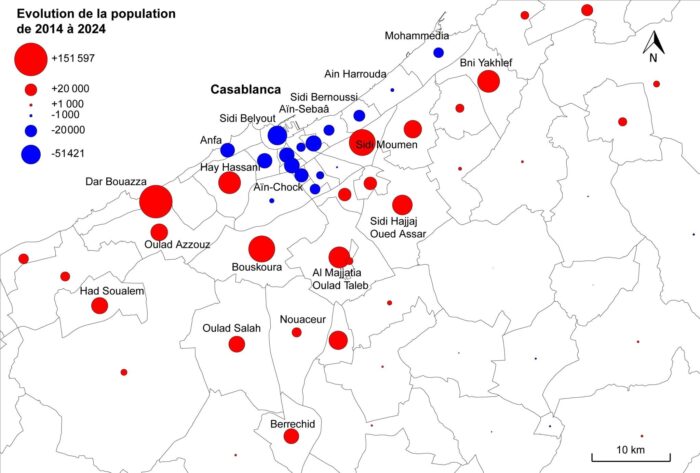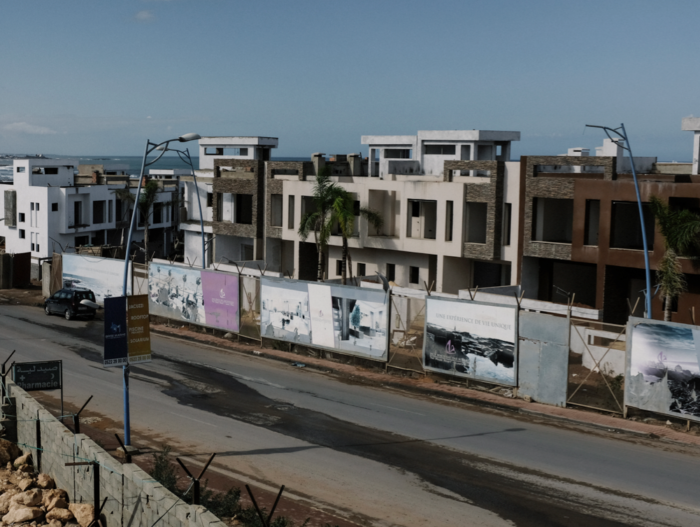However, things are changing drastically. According to data from the 2024 General Census of Population and Housing (RGPH), a large part of the population of downtown Casablanca is gradually being pushed out to the outskirts. This gentrification is not only changing the architectural identity of the economic capital, but also profoundly altering the socio-demographic characteristics of downtown Casablanca.
A study financed by the United Nations Development System (UNDS) and carried out by Professor David Goeury, PhD in geography and associate researcher at the Centre Jacques Berque in Rabat, highlights the different dynamics underway in the economic capital.
Low-income households leaving the city center
« Casablanca has lost 4% of its population in 10 years, to 3,343,642 inhabitants, despite strong growth in the districts of Sidi Moumen (21%) and Hay Hassani (15%), which now have over 500,000 inhabitants, with 551,443 (96,664) and 537,509 (68,967) respectively. All other districts are losing population. While Aïn Chock, Moulay Rachid and Sidi Othmane showed very moderate population losses, Anfa (-30%), Sidi Belyout (-27%) and Hay Mohammedi (-25%) lost more than a quarter of their population, while the outlying municipalities saw their populations grow very rapidly », reads the study.

For example, « the population of Dar Bouazza (302,970 inhabitants) doubled, with 151,597 new residents, while that of Bouskoura (200,359 inhabitants) grew by 95% (97,333). A similar situation was observed in Mohammedia (194,358 inhabitants), which lost 7% of its population, while Bni Yakhlef (117,653 inhabitants) grew by 143%. A satellite town like Had Soualem (74,762 inhabitants) grew by 103% ».
« The Greater Casablanca conurbation is growing by 13%, a rate still higher than the national average »
Ultimately, « the Greater Casablanca conurbation (including the prefectures and provinces of Casablanca, Mohammedia, Nouaceur, Médiouna and Berrechid) is growing by 13%, a rate still higher than the national average, with an overall gain of 635,593 inhabitants in ten years to 5,390,861 », continues the author of the report.
Contacted by TelQuel, David Goeury explains that behind this trend, two elements are intertwined: « on the one hand, the rural exodus, which is very strong, since we can see that many rural communes are losing population and that demographic growth in rural communes is lower than that observed in the rest of the country ».
Secondly, « there is a second movement of population within the Casablanca conurbation. It’s a movement that can be described as intra-urban, moving from the city’s historic centers to the outlying communes. So there are two dynamics here: the demographic dynamics of intra-urban movements, plus the historical dynamics of the rural world and small towns towards the Casablanca conurbation »
Land grabbing
These intra-urban movements are substantially shaping the socio-demographic attributes of the Moroccan metropolis. « When we talk about gentrification – as it is known in the European context – it’s the idea that there is a very rapid increase in the cost of land and rent, which leads to housing becoming unaffordable for the working and middle classes, » explains David Goeury.
« In Casablanca, there is a growing trend towards more and more empty housing »
And this is, strictly speaking, a mechanism in which the economic capital is becoming involved. « When you look at the situation in Casablanca, you can see that there’s very high inflation, to which is added a phenomenon that’s tending to become more pronounced: there are more and more empty homes ».
The gentrification process is thus giving way to « a complex process that is not land rent, but rather a means of conserving land capital without any desire to develop a regular income. It’s part of a guarantee logic. And this is very ambiguous, in the sense that certain categories, who have an abundance of income and a certain fear of risk-taking, engage in a process of land hoarding that can meet with a form of speculation. This means that housing is being hoarded because of risk aversion. This situation exacerbates the tension on the real estate market », continues our source.

Hoarding is not confined to certain neighborhoods, but also affects those redeveloped as part of the program to combat substandard housing. David Goeury explains: « There’s a problem we’re seeing in certain districts of Casablanca that have lost a lot of population, linked to the programs to combat informal housing. When these districts were demolished, they weren’t turned into low-cost or social housing, but were transformed for other purposes, notably mid-rise housing. And behind that, you have to be realistic, because if you have a temptation to hoard and investment made out of aversion to risk, you have strong pressure on this land. »
Another phenomenon is also underway, the shift of low- and middle-income populations from the coast to the interior. « The coastal zone, because of its attractiveness, will be destined mainly for tourism projects, especially in the context of the 2030 horizon, the organization of the World Cup, etc. The focus will be on tourism projects, in the form of hotels and tourist residences. And this, by its very nature, will mean that land will be inaccessible because it will have a specific use. The combination of these factors, namely the hoarding and tourist use of land, explains the fall in the number of inhabitants », said David Goeury.
Evolution of Casablanca’s total population :
2004 : 2.936.874
2014 : 3.359.818
2024: 3.218.036
Casablanca has always been described as a crossroads of contradictions. With its suburban neighborhoods lined with all kinds of insalubrious housing, the Moroccan metropolis has forged a reputation over the years and through stories as a place that concentrates to… pic.twitter.com/OIfZR83HwX-
TelQuel (@TelQuelOfficiel) March 24, 2025
Written in French by Amine Belghazi; edited in English by AngloMedia Group.




